News
Nearly a third of all women in developing countries become mothers during adolescence
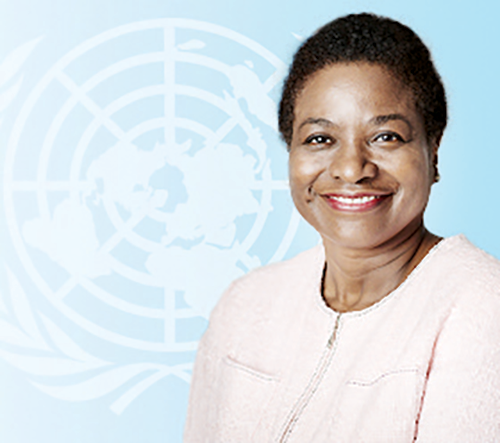
UNITED NATIONS,New York – Almost one third of women in developing countries had their first baby while they were still in their teens, a recently released report shows, with nearly half of those new mothers aged 17 and younger – still children themselves.
Gender-based and income inequalities are highlighted as key in fuelling teen pregnancies by increasing child marriage rates, keeping girls out of school, restricting their career aspirations, and limiting health care and information on safe, consensual sex. Entrenching these inequalities are climate disasters, COVID-19 and conflict, which are all upending lives around the world, obliterating livelihoods and making it more difficult for girls to afford or even physically reach school and health services. This leaves tens of millions yet more vulnerable to child marriage and early pregnancy.
“When nearly a third of all women in developing countries are becoming mothers during adolescence, it is clear the world is failing adolescent girls,” said UNFPA Executive Director Dr. Natalia Kanem. “The repeat pregnancies we see among adolescent mothers are a glaring signpost that they desperately need sexual and reproductive health information and services.”
Most births among girls under the age of 18 in 54 developing countries are reported as taking place within a marriage or union. Although more than half of those pregnancies were classified as “intended”, young girls’ ability to decide whether to have children can be severely constrained. Indeed, the report finds that adolescent pregnancy is often – albeit not always – driven by a lack of meaningful choice, limited agency, and even force or coercion.
Even in contexts where adolescent motherhood is considered acceptable and planned for, it can carry serious and long-term repercussions, especially when health-care systems fail to ensure accessible sexual and reproductive care and information for this vulnerable age group.
Complications in pregnancy and childbirth are the leading cause of death among girls aged 15 to 19 years, who are also far more likely to suffer a litany of other violations of their human rights, from forced marriage and intimate partner violence to serious mental health impacts of bearing children before they are out of childhood themselves.
Almost one third of women in developing countries had their first baby while they were still in their teens, a recently released report shows, with nearly half of those new mothers aged 17 and younger – still children themselves.
Gender-based and income inequalities are highlighted as key in fuelling teen pregnancies by increasing child marriage rates, keeping girls out of school, restricting their career aspirations, and limiting health care and information on safe, consensual sex.
Entrenching these inequalities are climate disasters, COVID-19 and conflict, which are all upending lives around the world, obliterating livelihoods and making it more difficult for girls to afford or even physically reach school and health services. This leaves tens of millions yet more vulnerable to child marriage and early pregnancy.
“When nearly a third of all women in developing countries are becoming mothers during adolescence, it is clear the world is failing adolescent girls,” said UNFPA Executive Director Dr. Natalia Kanem. “The repeat pregnancies we see among adolescent mothers are a glaring signpost that they desperately need sexual and reproductive health information and services.”
Most births among girls under the age of 18 in 54 developing countries are reported as taking place within a marriage or union. Although more than half of those pregnancies were classified as “intended”, young girls’ ability to decide whether to have children can be severely constrained. Indeed, the report finds that adolescent pregnancy is often – albeit not always – driven by a lack of meaningful choice, limited agency, and even force or coercion.
Even in contexts where adolescent motherhood is considered acceptable and planned for, it can carry serious and long-term repercussions, especially when health-care systems fail to ensure accessible sexual and reproductive care and information for this vulnerable age group.
Complications in pregnancy and childbirth are the leading cause of death among girls aged 15 to 19 years, who are also far more likely to suffer a litany of other violations of their human rights, from forced marriage and intimate partner violence to serious mental health impacts of bearing children before they are out of childhood themselves.
Girls who give birth in adolescence also often go on to have more than one baby in quick succession – which can be dangerous both physically and psychologically. Among those who first gave birth at age 14 or younger, nearly three quarters had a second baby before they turned 20, and a staggering 40 per cent of those had a third before they left their teens.
Adolescent births now account for 16 per cent of all births in the world, and the report shows women who began childbearing in adolescence had almost five births by the time they reached age 40. With inequalities and humanitarian crises multiplying and intensifying, we know women and girls are bearing an unequal burden of the consequent physical, psychological and economic turmoil.
In conflict as in climate disasters, schools and health facilities are frequently reduced to rubble and devoid of staff and equipment. Insecurity and violence render it impossible for people to move around even for basic necessities, including contraception and other critical sexual and reproductive health care.
Crises and displacement are also known to lead to spikes in gender-based and sexual violence, in turn causing more sexually transmitted infections, unwanted pregnancies from rape, and rising rates of forced and child marriages as parents struggle to cope with financial hardship and aching hunger. Under these circumstances, access to employment, education and health services is disrupted or suspended entirely, pushing girls out of school, women out of the workforce and leading child marriages and unintended pregnancies to soar.
News
Colombo Metropolitan Region, Eastern Development Plan and the Greater Hambantota Project discussed in detail
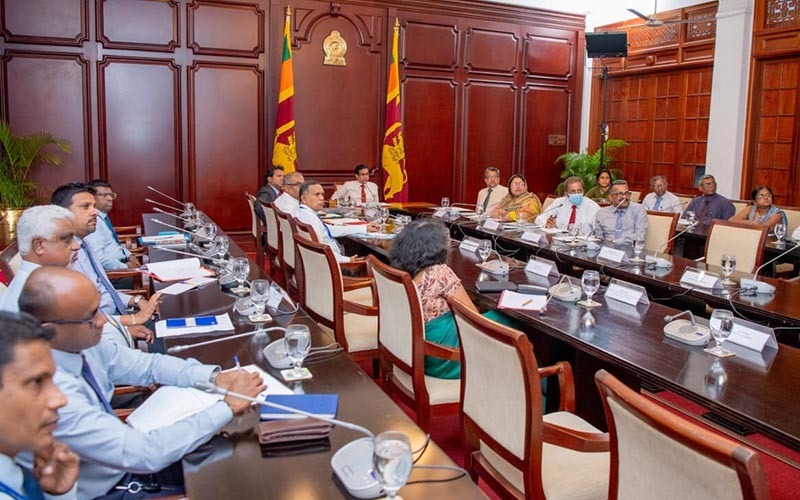
A meeting between Secretary to the President, Dr. Nandika Sanath Kumanayake and relevant ministry officials was held on Tuesday (08) at the Presidential Secretariat regarding the development plans to be implemented in Sri Lanka under three zones, in collaboration with the Surbana Jurong Institute of Singapore and 18 Ministries.
During the meeting it was discussed in detail regarding the plans for the Colombo Metropolitan Region, Eastern Development Plan and the Greater Hambantota Project. The officials from Singapore-based urban planning and infrastructure consultancy Surbana Jurong also joined the discussion virtually.
Progress reports on the three projects were reviewed in detail and Dr. Kumanayake instructed the officials to identify any deficiencies and finalize the necessary actions within the next two weeks.
The discussion also addressed delays in securing necessary approvals for investments under the existing regulatory framework, as well as the urgent need to revise certain legislative instruments to better facilitate national development.
The meeting was attended by Secretary to the Prime Minister G.P. Saputhanthri, Senior Additional Secretary to the President Russel Aponsu, Secretary to the Ministry of Urban Development, Construction and Housing U.G. Ranjith Ariyaratne, and several senior officials from the respective ministries.
News
Heat index at ‘Caution level’ in Northern, North-central, Eastern, North-western, Western provinces and Monaragala district today [09]
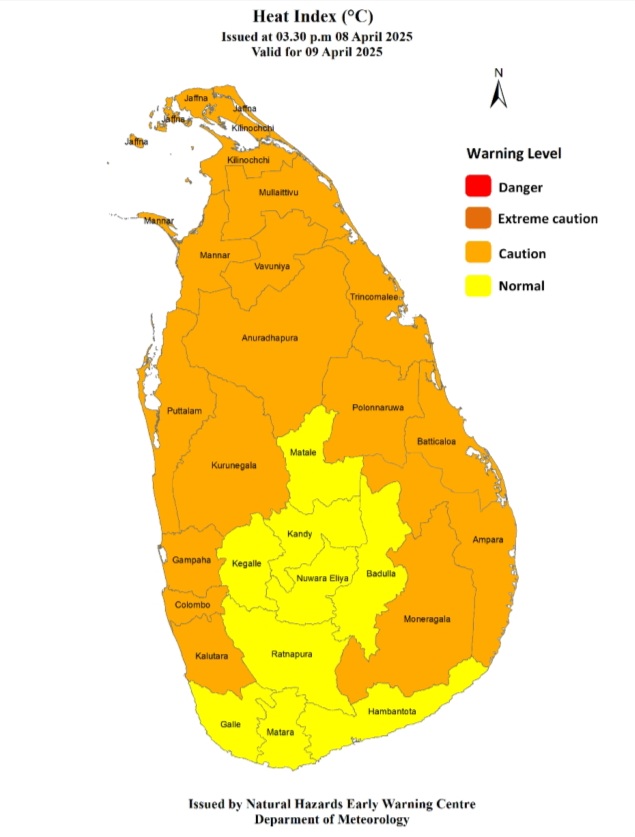
The Natural Hazards Early Warning Centre of the Department of Meteorology has issued a Warm Weather Advisory for 09 April 2025
The public are warned that the Heat index, the temperature felt on human body is likely to increase up to ‘Caution level’ at some places in Northern, North-central, Eastern, North-western, and Western provinces and in Monaragala district.
The Heat Index Forecast is calculated by using relative humidity and maximum temperature and this is the condition that is felt on your body. This is not the forecast of maximum temperature. It is generated by the Department of Meteorology for the next day period and prepared by using global numerical weather prediction model data.
Effect of the heat index on human body is mentioned below is prepared on the advice of the Ministry of Health and Indigenous Medical Services.
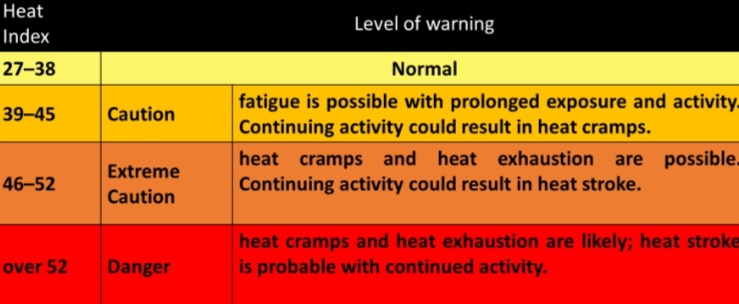
ACTION REQUIRED
Job sites: Stay hydrated and takes breaks in the shade as often as possible.
Indoors: Check up on the elderly and the sick.
Vehicles: Never leave children unattended.
Outdoors: Limit strenuous outdoor activities, find shade and stay hydrated. Dress: Wear lightweight and white or light-colored clothing.
Note:
In addition, please refer to advisories issued by the Disaster Preparedness & Response Division, Ministry of Health in this regard as well. For further clarifications please contact 011-7446491.
News
Sajith asks govt. to submit its MoUs with India to Parliament
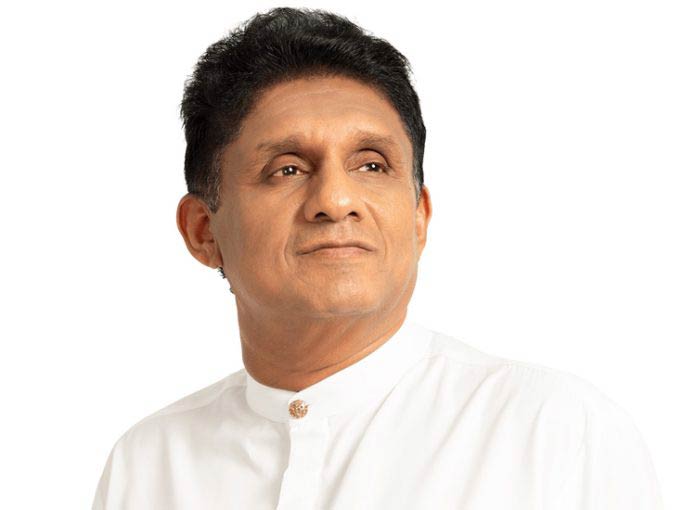
Prof. Jayasumana raises possibility of Lanka ending up with “Quad’
Opposition and SJB Leader Sajith Premadasa has said it is the responsibility of the NPP government to submit the MoUs/agreements that were recently signed with India to the respective Sectoral Oversight Committees (SOCs).
Premadasa said so when The Island raised the issue with him. He said that during his meeting with Premier Modi his focus had been on opening the Indian market for Sri Lankan garment exports.
The seven MoUs/agreements signed on 05 April included defence cooperation, energy, Eastern Province development and digitalisation.
Meanwhile, the Vice President of Sarvajana Balaya and former lawmaker Prof. Channa Jayasumana said that the government owed an explanation whether the recently signed MoU on defence cooperation directly or indirectly attached Sri Lanka to the Quad security alliance, consisting of the US, Australia, Japan and India.
 The former SLPPer raised the issue at a meeting held at Boralesgamuwa on Monday (07) in support of Sarvajana Balaya candidates contesting the May 6 LG polls.
The former SLPPer raised the issue at a meeting held at Boralesgamuwa on Monday (07) in support of Sarvajana Balaya candidates contesting the May 6 LG polls.
Prof. Jayasumana urged that the MoU on Defence Cooperation be placed before Parliament, and the people, without further delay. The academic who served as State Health Minister during President Gotabaya Rajapaksa’s tenure said that President Anura Kumara Dissanayake’s foreign policy direction should be dealt with.
By Shamindra Ferdinando
-

 Business3 days ago
Business3 days agoColombo Coffee wins coveted management awards
-

 Business5 days ago
Business5 days agoDaraz Sri Lanka ushers in the New Year with 4.4 Avurudu Wasi Pro Max – Sri Lanka’s biggest online Avurudu sale
-

 Features4 days ago
Features4 days agoStarlink in the Global South
-

 Business6 days ago
Business6 days agoStrengthening SDG integration into provincial planning and development process
-

 Business5 days ago
Business5 days agoNew SL Sovereign Bonds win foreign investor confidence
-

 Sports6 days ago
Sports6 days agoTo play or not to play is Richmond’s decision
-

 Features4 days ago
Features4 days agoModi’s Sri Lanka Sojourn
-

 Midweek Review12 hours ago
Midweek Review12 hours agoInequality is killing the Middle Class











